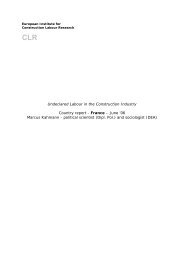Japan – what can we learn? - Construction Labour Research
Japan – what can we learn? - Construction Labour Research
Japan – what can we learn? - Construction Labour Research
Create successful ePaper yourself
Turn your PDF publications into a flip-book with our unique Google optimized e-Paper software.
is constructed without blueprints. On construction sites, generalcontractors do not need to show how to build it; rather, the building issimply built based on each drawing by the skilled. This is the veryunique and strange feature of <strong>Japan</strong>ese construction. They inherentlywork in that manner without calling on the return, contrary to thenormal business manner in other contract situations.”To summarize the history of this responsible construction, I brieflyreview how the organisation of production has developed in <strong>Japan</strong>eseconstruction. In the early 1970s, technical innovation of generalcontractors forced the deepening of multi-subcontracting layers andalliance of enterprises. In the labour process, the standardisation oftasks and the demand for multi-skilling proceeded, with managementledworkers taking responsibility for the quality of work by makingsmall groups for each task. The signifi<strong>can</strong>t function of foreman alsoshifted from training craftsmen to collecting un/semi-skilled workers.This process resulted in an intensification of labour and pursuit of thebetter productivity. In the 1980s, faced with a construction recession,general contractors intensified the rationalisation of production,reduced the numbers allocated on site, and began to placeresponsibility for management onto specialist subcontractors. Specialenterprises with company-specific techniques also became responsiblefor management techniques in production processes. Companies,which mainly supply labour, became responsible for schedule control,allocating workers, processing tasks, and so on. In the late 1980s,dominated by orders through nominated contracts for huge projects,general contractors put more and more emphasis on “responsibleconstruction” by specialist subcontractors, who sustain technologiesand management skills. At the same time, the shortage of skilledcraftsmen stimulated the inclusion of foremen by general contractorswith company-based license systems. Ho<strong>we</strong>ver, at present, mostskilled workers are employed by small secondary or third layercompanies, not even by the primary subcontractor, or they are selfemployed.In the 1990s, contracting conditions changed in theeconomic recession after the bubble. The linkage of general contractorand primary sub-contractor <strong>we</strong>akened. The special contractor facedunstable market conditions with increasing pressure to reduce unitcosts by the general contractors. Many specialist subcontractors beganto seek orders from less intimate general contractors. This intensifiedthe competition in construction and caused price dumping. BecauseCLR News No 2/200634









